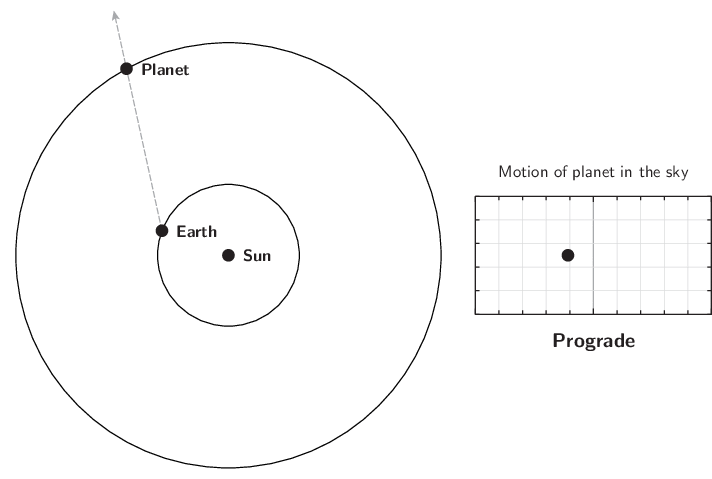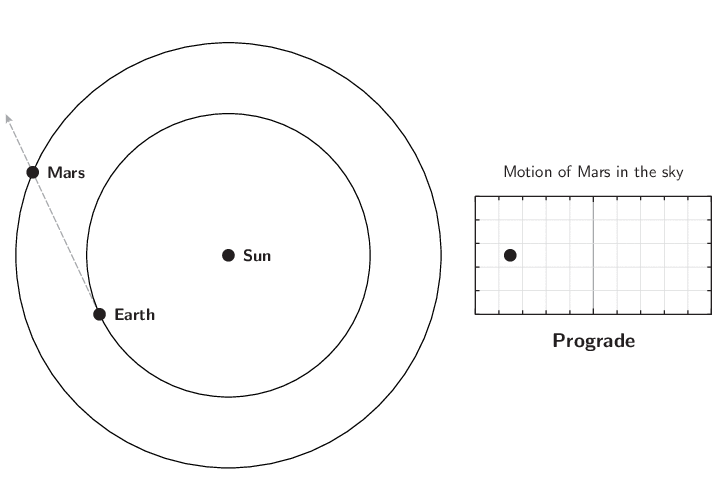Retrograde Motion
Apparent retrograde motion is a phenomenon that the solar system's outer planets periodically undergo, when they spend a few months moving through the constellations in the opposite direction to their usual direction of travel.
This motion was known to ancient observers, and it troubled them as they could not reconcile it with models in which the planets moved in uniform circular orbits around the Earth, as they believed.
The retrograde motion is caused by the Earth's own motion around the Sun. As the Earth circles the Sun, our perspective changes, and this causes the apparent positions of objects to move from side-to-side in the sky with a one-year period. This nodding motion is super-imposed on the planet's long-term eastward motion through the constellations.
Since the orbital speeds of the planets decreases with distance from the Sun, the Earth moves faster than any of the outer planets: Mars, Jupiter, Saturn, Uranus and Neptune. This means that the apparent nodding motion induced by the Earth's orbital motion dominates over these planets' own eastward motion along their orbits. Other objects in the outer solar system, including asteroids and comets, also orbit the Sun more slowly than the Earth and exhibit retrograde motion.
The diagram below illustrates how retrograde motion comes about. The grey dashed arrow shows the Earth's sight-line to the planet, and the diagram on the right shows the planet's apparently movement across the sky as seen from the Earth:

The retrograde motion of a planet in the outer solar system, such as Jupiter.
Not drawn to scale.
Planets which are further from the Sun spend more time in retrograde motion, since they move comparatively slowly around their orbits, and their apparent motion is dominated by the Earth's orbital motion.
Of all the planets, Mars spends the least time in retrograde motion since its orbital speed is the most similar to the Earth's. It spends around 72 days in retrograde motion each time it passes opposition.

The retrograde motion of Mars, which orbits the Sun at around
1.52 AU and
spends comparatively little time in retrograde motion.
Not drawn to scale.
Objects in retrograde motion in 2025
The table below lists the dates when objects are in retrograde motion in 2025, computed from NASA's DE430 planetary ephemeris. To show events in other years, use the control below.
| Date | Object | Declination |
| Date | Object | Declination |
| 30 Jan 2025 08:16 PST | Uranus ends retrograde motion | 18°15'N |
| 04 Feb 2025 01:38 PST | Jupiter ends retrograde motion | 21°36'N |
| 23 Feb 2025 18:02 PST | Mars ends retrograde motion | 26°03'N |
| 04 Jul 2025 14:30 PDT | Neptune enters retrograde motion | 0°29'S |
| 12 Jul 2025 21:00 PDT | Saturn enters retrograde motion | 1°28'S |
| 05 Sep 2025 22:17 PDT | Uranus enters retrograde motion | 20°10'N |
| 11 Nov 2025 08:37 PST | Jupiter enters retrograde motion | 21°16'N |
| 27 Nov 2025 19:45 PST | Saturn ends retrograde motion | 4°15'S |
| 10 Dec 2025 04:13 PST | Neptune ends retrograde motion | 1°37'S |